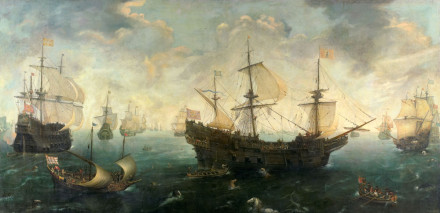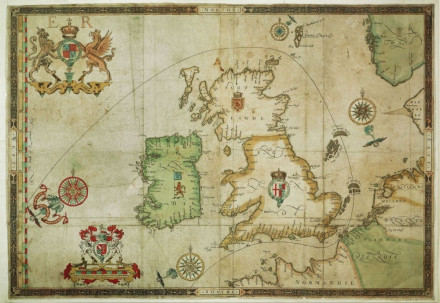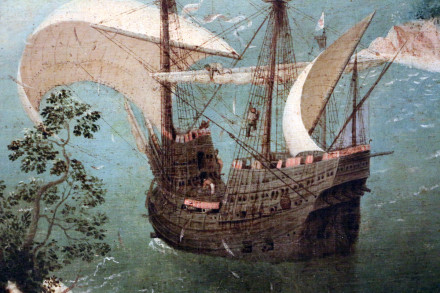History
The Santa Maria de la Rosa was part of the great Spanish Armada that sailed from Lisbon in June 1588. Captain of the ship was Martin de Villafranca, a Basque. The ship was badly damaged in a storm near La Coruna and lost her main mast. After some difficulties she was repaired and could continue her voyage. During the actual fighting against the English she was in the rear of the Armada, exposed to constant English gunfire.
To escape back to Spain, the Armada took the route to the north of Scotland and western Ireland. The fleet was scattered and over 20 ships were wrecked on the Irish coast. The Santa Maria, already heavily damaged, got as far as the Blasket Sound on the far southwest coast of Ireland. She tried to find shelter behind Great Blasket Island from a storm but lost her anchor and ran on an underwater reef. The ship sank instantly.
Only one crew member survived, a boy named Giovanni. This boy was interrogated thoroughly and told many details about the crew, officers and the sinking of the ship.
The Spanish Armada
The Armada's commander was Medina Sidonia. The fleet set out with 22 warships of the Spanish Royal Navy and 108 converted merchant vessels, with the intention of sailing through the English Channel to anchor off the coast of Flanders, where the Duke of Parma's army of Tercios would stand ready for an invasion of the south-east of England. The Armada achieved its first goal and anchored outside Gravelines, at the coastal border area between France and the Spanish Netherlands. While awaiting communications from Parma's army, it was driven from its anchorage by an English fire ship attack, and in the ensuing Battle of Gravelines the Spanish were forced to abandon their rendezvous with Parma's army.

Disaster
The Armada managed to regroup and withdraw north, with the English fleet harrying it for some distance up the east coast of England. A return voyage to Spain was plotted, and the fleet sailed into the Atlantic, past Ireland. But severe storms disrupted the fleet's course, and over 24 vessels were wrecked on the northern and western coasts of Ireland, with the survivors having to seek refuge in Scotland. Of the initial fleet, about 50 vessels failed to make it back to Spain.

Description
The Santa Maria de la Rosa was a large Mediterranean built merchant carrack, probably from Venetian or Genoese origin. She was refitted as a first rate warship, resulting in a relatively light hull with long, heavy masts. This combination made the ship unsuitable for Atlantic weather conditions. This kind of reworked merchant vessel formed the bulk of the Spanish Armada sailing against England in 1588. The Santa Maria was the vice admiral of the Guipúzcoa squadron (with a mostly Basque crew) during the Armada's planned invasion of England in 1588. She was a large merchant vessel and a slow sailor more suitable for carrying supplies and soldiers than for fighting battles.
Armament: 26 guns
Crew: 64 sailors, 233 soldiers.

| Master | Martin de Villafranca |
|---|---|
| Length | 88 ½ feet (27 m) |
| Tonnage | 945 ton (473 last) |
Status
Excavation
During an expedition in 1968 the wrecksite was found. Part of the ballast stones were discovered with underneath them a part of the hull planking and the mast step of the main mast. Many cannonballs were found, but no cannons. The ship had broken in two parts. The stern part with the castle and guns had been carried off by the currents and was not found.